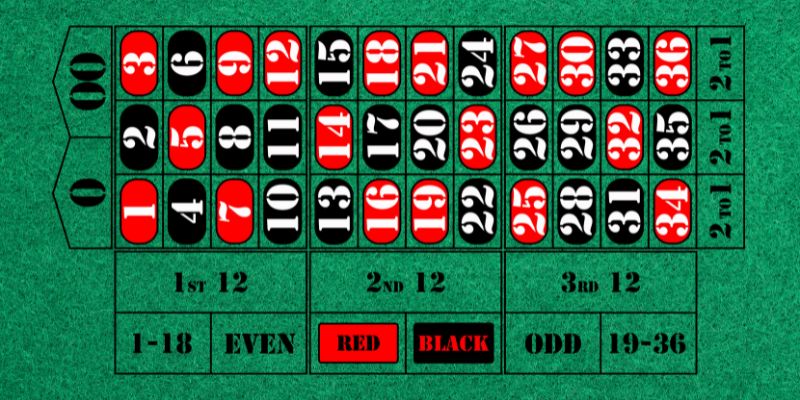A Complete Guide to the Fibonacci Roulette Strategy
The Fibonacci Roulette Strategy is a betting strategy that uses the Fibonacci sequence to determine how much to bet on each round of roulette, live dealer roulette, or online roulette. This strategy is based on the idea that losses can be recouped by increasing your bets in a specific sequence. In Roulette, where luck plays a significant role, having a sound betting strategy is crucial to maximizing your winnings.
The objective of this article is to provide a comprehensive guide to the Fibonacci Roulette Strategy, explaining how it works, its advantages and disadvantages, and how to apply it effectively. The article will cover the Fibonacci sequence and how it is used in the strategy, the different variations of the strategy, including the reverse Fibonacci system, and how to use a Fibonacci Roulette calculator to calculate your bets.
We will also explore the pros and cons of using the Fibonacci Roulette Strategy and discuss other popular betting systems. Finally, we will explain the Fibonacci Roulette payout and provide some tips on how to increase your chances of winning with this strategy. By the end of this article, you will have a deep understanding of the Fibonacci Roulette Strategy and how to use it to maximize your winnings at the Roulette table.
Understanding the Fibonacci Roulette Strategy
The Fibonacci Roulette Strategy is a betting system that is based on the Fibonacci sequence, a series of numbers that starts with 0 and 1, with each subsequent number being the sum of the previous two. The sequence goes 0, 1, 1, 2, 3, 5, 8, 13, 21, 34, 55, 89, and so on. This sequence is named after the Italian mathematician Leonardo of Pisa, who is also known as Fibonacci.
The Fibonacci sequence is used in the Roulette betting strategy by using it to determine the amount of the bet for each spin. The idea is to start with a small bet and increase it according to the sequence after each loss. The sequence is used to determine the next betting amount, so the bets increase in a gradual and controlled way.
To use the Fibonacci sequence for Roulette betting, the player starts by placing the first bet at the minimum amount, usually the table minimum. If the bet wins, the player goes back to the beginning of the sequence and starts again with the minimum bet. If the bet loses, the player moves to the next number in the sequence and places a bet for that amount. If this bet loses as well, the player moves to the next number in the sequence and continues to do so until they win a bet.
For example, if a player starts with a $5 bet and loses, the next bet will be $5 again because it is the first number in the Fibonacci sequence. If they lose again, the next bet will be $10 (the second number in the sequence), and if they lose again, the next bet will be $15 (the third number in the sequence). This continues until the player wins a bet, at which point they start over again with the minimum bet of $5.
One advantage of the Fibonacci Roulette Strategy is that it allows for gradual betting increases, which can help manage a player’s bankroll and prevent them from losing a large amount of money all at once. Additionally, the strategy is relatively easy to learn and can be used by players of all experience levels.
However, there are also some disadvantages to using the Fibonacci Roulette Strategy. One is that it does not guarantee that a player will win, and they may end up losing more money than they intended. Additionally, the strategy requires the player to have a large enough bankroll to be able to continue betting at higher amounts if they experience several losses in a row.
Implementing the Fibonacci Roulette Strategy
The strategy is popular in roulette because it is easy to understand and implement, and it allows for players to take advantage of the even odds of red/black, high/low, or odd/even bets.
The basic premise of the Fibonacci Roulette Strategy is to use the Fibonacci sequence to determine the size of each bet. The strategy involves starting with a small bet and then increasing the bet size by moving up the Fibonacci sequence for each loss, and moving back down the sequence for each win. Here is an example of how the strategy works:
- Start with a minimum bet size, such as $1.
- If the bet wins, go back to the minimum bet size.
- If the bet loses, move up one step in the Fibonacci sequence and use that number as the new bet size. For example, if the first bet was $1 and it lost, the next bet would be $1 (the minimum bet size) plus $1 (the previous bet size), for a total of $2.
- Continue to move up the Fibonacci sequence for each loss and move back down the sequence for each win.
Using the Fibonacci Roulette Strategy in practice requires some discipline and careful bankroll management. Players must be careful not to get too carried away with increasing bet sizes, and must be willing to take a loss and move back down the sequence if things start to go poorly. The strategy is also best used with even money bets, such as red/black or odd/even, as these have the highest odds of winning.
To implement the Fibonacci Roulette Strategy, follow these steps:
- Choose an even money bet, such as red/black, odd/even, or high/low.
- Start with a small bet size, such as $1.
- If you win the bet, start again with the minimum bet size.
- If you lose the bet, move up one step in the Fibonacci sequence and use that number as the new bet size.
- Continue to move up the Fibonacci sequence for each loss and move back down the sequence for each win.
Managing your bankroll is crucial when using the Fibonacci Roulette Strategy. Here are a few tips:
- Set a budget: Before you start playing, decide how much money you are willing to spend on the Fibonacci Roulette Strategy. Stick to this budget and do not exceed it.
- Start with small bets: To avoid losing your bankroll quickly, start with small bets. Remember that the Fibonacci sequence increases exponentially, so your bets will become larger quickly.
- Keep track of your bets: It is important to keep track of your bets when using the Fibonacci Roulette Strategy. Write down each bet you place, the size of the bet, and the outcome of the bet.
- Take breaks: Take breaks regularly to give yourself time to think about your strategy and to avoid making impulsive decisions.
- Don’t chase losses: If you are on a losing streak, don’t try to recoup your losses by increasing your bets. Stick to your strategy and wait for your luck to turn.
- Quit while you’re ahead: If you have won a significant amount of money, consider quitting while you’re ahead. The Fibonacci Roulette Strategy can be unpredictable, so it’s better to leave the table with a profit than to risk losing it all.
It is important to remember that the Fibonacci Roulette Strategy does not guarantee a win, as it is a betting system and not a way to cheat the game. However, it can be a fun and engaging way to play roulette, and it can help to manage your bankroll by setting clear limits on your bet sizes.
Fibonacci Roulette Strategy vs. Other Betting Strategies
Roulette is a popular casino game that involves betting on the outcome of a spinning wheel with numbered pockets. There are various betting strategies that players can use to increase their chances of winning, but no strategy can guarantee a win. In this article, we will compare the Fibonacci Roulette Strategy with other popular Roulette betting strategies, such as Martingale and D’Alembert, and discuss their strengths and weaknesses.
The Fibonacci Roulette Strategy
Strengths:
- It is a relatively low-risk strategy because the bets increase slowly.
- It has a good chance of making up for previous losses with just one win.
- The sequence can be continued for as long as the player wants to play.
Weaknesses:
- It does not guarantee a win.
- It can take a long time to recover from a losing streak.
- It can be difficult to keep track of the sequence, especially if a player loses several times in a row.
Martingale Roulette Strategy
Strengths:
- It can be very effective in short-term play, as a player only needs one win to recover all losses.
- It is simple to understand and apply.
Weaknesses:
- It requires a large bankroll to avoid going bankrupt.
- It can result in large losses if a player experiences a long losing streak.
- Casinos often have betting limits, which can prevent players from using the strategy effectively.
D’Alembert Roulette Strategy
Strengths:
- It is a relatively low-risk strategy because the bets increase slowly.
- It is easy to understand and apply.
- It can be used with any even-money bet in roulette.
Weaknesses:
- It does not guarantee a win.
- It can take a long time to recover from a losing streak.
- It may not be effective in the long-term.
There are several reasons why the Fibonacci Roulette Strategy may be a more favorable option for certain types of players:
- Controlled Risk: The Fibonacci system is a progressive betting strategy that involves increasing your bet after a loss. However, the increase is not as steep as in other progressive systems like the Martingale system. This means that players can enjoy a higher degree of control over their risk and exposure to losses.
- Longer Playing Time: Because the bets increase at a slower pace, players who use the Fibonacci system can enjoy longer playing time than they would with other betting strategies. This can be appealing to players who prefer a more leisurely pace to their gameplay and want to stretch their bankroll.
- No Guaranteed Wins: The Fibonacci Roulette Strategy does not guarantee wins, and there is always the risk of losing. However, it can be a more conservative betting strategy that allows players to manage their bankroll more effectively and reduce their losses over time.
- Suitable for Conservative Players: The Fibonacci system is suitable for players who prefer a more conservative betting strategy and want to minimize their risk. It is particularly suitable for players who want to enjoy the game of roulette without taking too much risk.
Common Mistakes to Avoid
There are several common mistakes that players make when implementing this strategy, which can have negative consequences on their gameplay.
One of the most common mistakes is failing to set a betting limit or chasing losses. Since the Fibonacci sequence involves increasing your bets after each loss, it can be tempting to continue betting even after reaching your initial betting limit. This can lead to significant losses and a depleted bankroll.
Another mistake is relying solely on the Fibonacci sequence without considering other factors such as the odds and house edge of the game. It is important to understand the game and the probabilities involved in each bet to make informed decisions.
Other mistakes include not tracking your wins and losses, not adjusting your betting sequence according to your bankroll, and not taking breaks to avoid burnout or emotional decision-making.
To avoid these mistakes, it is important to have a solid understanding of the Fibonacci Roulette Strategy and how it works, set clear betting limits, and keep track of your wins and losses. Take breaks and avoid emotional decision-making, as this can lead to impulsive bets and losses.
Reflect on your gameplay and identify the mistakes you made, then develop strategies to avoid them in the future. Practice good bankroll management and consider trying out different betting systems to find what works best for you.
In summary, when implementing the Fibonacci Roulette Strategy, avoid common mistakes such as not setting clear betting limits, relying solely on the Fibonacci sequence, and not tracking your wins and losses.
Fibonacci Roulette Strategy Takeaways
While the Fibonacci Roulette Strategy can be an entertaining way to play roulette, it’s important to note that no betting system can guarantee a win. Roulette is a game of chance, and the outcome of each spin is entirely random. The Fibonacci system is also not immune to the gambler’s fallacy, which is the belief that past events influence future outcomes in a game of chance.
In short, the effectiveness of the Fibonacci Roulette Strategy is limited. While it may be fun to play with, it’s important to remember that there is no surefire way to win at roulette or any other game of chance. Players should always gamble responsibly and within their means and view any betting system as a way to manage their bankroll rather than a way to guarantee a win.







